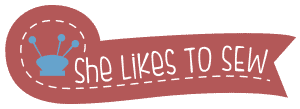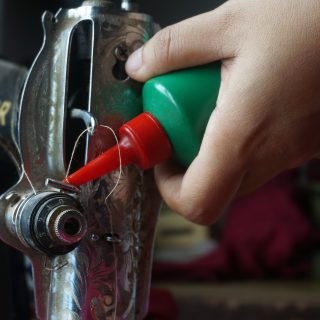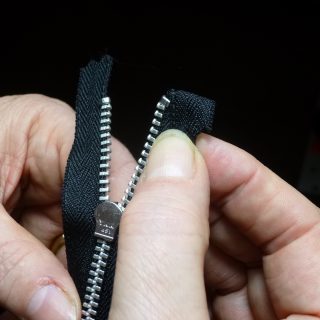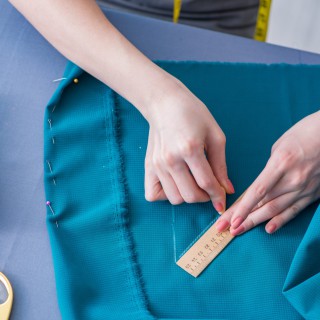Every now then we all like to feel a little bit French, and by that, I mean stylish and well dressed.
However, what the French are also good at when it comes to fashion is making small, simple things look fabulous.
A beret hat used to be quite popular in France and Spain during the nineteenth century, and the hat itself can be associated with many things: the revolution, military uniforms, but also elegance and fashion.
Although, you’ll be surprised to hear that it was traditionally worn by the French shepherds from Basque before they paved their way into the revolutionary and even sophisticated heads.
You will admit – not many accessories can so easily be adapted to so many different contexts.
Traditionally, berets are made of wool felt. This type of material is usually sold in utility fabric sections of fabric stores. The hat has a round, flat shape, and since it’s quite soft, you can wear it in different ways on your head.
A good side to wool felt is that it comes in a wide range of beautiful colors. The not-so-good side is that wool can be itchy for the skin and it can dry your hair, so you might want to line the inside with another material.
Buying a good beret today is quite expensive. But luckily, it’s very easy to make them. To make your own beret hat, all you need is a couple of tools, fabric supplies, and to follow this tutorial.
How to Make a Beret Hat: Step by Step Guide
If you’ve worked on sewing projects before, you probably know the golden rule: preparation is a job half done.
So, before we jump to steps you need to take to sew your beret hat, let’s see what kind of tools and supplies you need.
Tools and Supplies
Here are some of the basic tools and supplies for making a beret.
- A good tailor’s measuring tape. You will need it to measure around your head and determine the size of the hat.
- Fabric: wool felt, no more than ½ yard.
- If you are going to make lining (which I strongly recommend), another ½ yard of lining fabric.
- Scissors/Rotary cutter/Cutting machine.
- Working/cutting mat if you prefer.
- Coordinating thread.
- Compass.
- A piece of paper.
- Pen, pencil, or a fabric marker.
- Needles for hand sewing.
- Pins.
Creating the Pattern
Got all of your supplies? Great. The first step to making your own beret hat is to make a pattern.
The pattern for a beret usually has two parts: the top and the underside. Make sure to leave about ¼ inch for a seam allowance.
The Top
The top of the beret is basically a large circle, so your task will be to make one on a piece of paper.
To make a proper top side, you can use a generic adult hat size which is around 12 inches in diameter, along with some ¼ inch allowance.
Then, take the compass, and set it to the value of the radius of the circle. If you’re using a 12-inch diameter as a measure, the radius will be 6 inches or half of the diameter.
You can also use another measurement, according to your preference.
The Underside
For the underside, you can use the same circle that you used for the top. However, for this, you will need to use the measuring tape and determine the exact distance around your head. This measure will be the inner circle circumference. That’s the opening where your head goes into the beret.
Calculating the radius of a circle: R = C/2π (C is the circumference of the circle, π=3.14).
The value of the radius you calculate is the value you will set on the compass to create the inner circle.
Finally, cut the inner circle out of the big circle and separate the top from the underside.
Preparing the Fabric
Now, cut out the pattern from both the wool felt and lining. In one of our previous articles on how to cut fabric straight, you can find great recommendations for cutting machines, rotary cutters, and scissors, as well as tips on how to protect yourself from injury. However, in this case, cutting will be performed a bit differently, as you need to cut the fabric round, which is why you are relying on the pattern.
After cutting the beret pattern from both fabrics, cut a 2-inch long and ¼ inch wide strip of fabric that will serve as a “stem” at the center of the beret.
Next, take the “wrong” sides of the beret top together and fold the beret top in half, and then in quarters. Take a pen or other marking tool and mark the point. This is where the stem will go – it’s the center of your beret.
The last step of the preparation is to pin the underside to the beret top, by putting the right sides together.
Sewing the Beret
Finally, the time has come to turn on the good old sewing machine! After many steps of preparation, you are now ready to start sewing your beret.
But first, (there’s always one more step!), you need to make the stem. Take the 2-inch fabric strip and sew its ends together. Because it’s such a small piece, you can hand sew it with a little bit of color-matching thread.
Then, stitch the stem to the center of the top side of the beret – it’s where you left the mark, remember?
Now, start stitching your beret alongside the pin marks. Make sure to leave at least ¼ inch of the seam allowance. Once you’ve stitched along the whole circle, flip the wool felt inside out (to what will now be the outer side).
Use an iron to flatten the seam and make further sewing easier.
The Lining
Now, take the lining fabric and pin the top and the underside like you already did with wool felt, putting the right sides together, and sew them together with the same ¼ of an inch seam allowance.
Measure some ¼ of an inch from the inner circle of the lining and cut it to reduce the amount of fabric. This is necessary for the lining not to peek out underneath the wool felt.
When you stitch the pieces of lining to each together pin the lining on the wool felt (on the beret) by putting the right sides together and leaving some 4 inches opening maximum.
Once again, turn your machine on, and sew the fabrics together.
Turn the beret to the correct side and hand sew the opening to close it. Voila – you have a wool-felt beret!
Alternative Options
When it comes to achieving the form of a beret hat, there’s no other algorithm – the round pattern that you need to draw on paper and then apply when cutting the fabric stays the same.
But what can be done differently?
For example, you can choose softer wool felt or handwash it with a fabric conditioner so it doesn’t feel itchy when you put it on your head. Then, you can lose the lining from the hat if that’s how what prefer. That way, both the sewing and the preparation will be much quicker.
Also, although the small fabric stem is the most common decor on the beret, you can in fact do whatever you want on the top. Add some embellishment, a tassel, or a pompom, according to your preference.
Another alternative thing you can do is to sew an elastic band inside the underside of the beret. Although this hat is mostly worn by leisurely putting it on your head, for some different writing styles, and also for tougher weather, the elastic band can do miracles (keep your beret on despite the wind, help hold the beret firmly on your head on one side, while it’s leisurely set on the other, etc).
Making a Paper Beret for Kids
And while the wool felt beret is the most commonly wanted type of beret, you can also make a paper beret for your kid if they need it for a costume party, to play around, or to do arts and crafts together.
Making a paper beret is of course much simpler and requires different supplies.
Paper Beret Supplies
- Crepe paper. The best type is thick crepe paper because thin tissue paper is too weak for this project.
- A measuring tape.
- A pair of good scissors.
- Pen/pencil/marker.
- Smaller and bigger circle pattern, depending on your child’s head size.
Step by Step Guide
Take several pieces of crepe paper and pile them on top of each other.
Take the circle pattern and draw it on the first piece of paper, imprinting it on the lower layers. The crepe papers are set in layers because you will need several pieces of them, so cut carefully through the layers.
To draw a perfect circle, you can simply use a compass, like in the previous example.
Then, draw a smaller circle within the circle made of crepe paper. The smaller circle should match the child’s head size. Make sure that the center of the smaller circle exactly matches the center of the bigger one, because otherwise, the beret will not look like a hat.
Once drawn, cut the inner circle out. You will only need the outer side for the hat, so make sure that you don’t damage it, but the inner one you can damage while cutting, it’s no big deal.
Now, take the outer circle from the previous step and attach it to the one you cut out. You can glue them together, hand sew, or carefully sew with a machine.
If you’re confident to sew paper with thread and needle, I would strongly recommend this, as thread makes for a nice decoration.
What would also work is a double-sided tape, but be careful to align it as close as you can to the edges.
Finally, the most fun part: decoration! Berets are traditionally single-colored and without any ornaments, but this is your child’s project and they can do whatever they want with their fun paper beret.
Add some sparkle to it with glitter, draw something, or cover it in stickers.
A bunch of these creative berets would work great for a French-themed kids’ party, so every child would get one hat and they would decorate it however they want.
Knitted Beret
For those of you who enjoy knitting, here’s a tutorial for making a knitted beret, an excellent accessory for cold winter days.
Supplies
- A pattern. To make a knitted beret you’ll need a knitting pattern. You can either purchase one online, at your local shop, or use some of these free samples. The pattern should have an interesting design, but also match your skill level in knitting.
- Yarn and needles. A yarn should match the chosen pattern, and the pattern will outline the weight of the yarn necessary as well as the needle size. The yarn you choose should feel nice on your skin.
- Circular knitting needles.
Knitting the Beret
If your knitting skills are a bit rusty, consider knitting a sample first, before jumping into the beret knitting project. Making a sample first is also good to see how the yarn feels in your hands and to figure out which stitches you need to use while knitting.
First, you need to knit a certain number of stitches on your needles. The number of these stitches should match your head circumference. For an adult head size, it’s usually some 60 stitches more or less.
Then, knit a few rows, each of them having the same length. These first few rows will be the band of the beret, and from there on, you can increase the stitches in regular intervals, as your project grows in size.
When you reach the middle point of the beret, it’s time to reduce the stitches. In the middle of the beret, the flare is usually the widest. By reducing the stitches you will make the beret look flat like it’s supposed to.
To finish the beret you will need to reduce down your stitches to almost a dozen. When you reach the minimum number of stitches possible, you can tie them all together on the top.
Finally, by sewing the ends of the swatch together along the side of the hat, you can finish the beret. This is how you achieve its perfectly round shape.
Conclusion
Good looking and simple to make, berets are by far some of the most elegant hats you can wear. They look good in every combination: you can wear them with jeans and a sweater, but also with an elegant coat.
They are a good choice for men, women, and children alike, and they look equally good when they’re made of wool felt or knitted yarn.
Of course, there’s also the paper beret, but this one is mostly for fun, which is why it makes a good arts and crafts project for kids. It combines well for a themed or costume party, and it’s great fun to make it and design it.
Thank you for reading my article, I hope you find what you were looking for. Enjoy making and wearing your beautiful beret. If you’re looking for more tutorials, check out my website and learn how to fix ripped jeans, how to make the jeans bigger, or as Halloween is approaching, you might want to take a peek into how to make fabric pumpkins.





